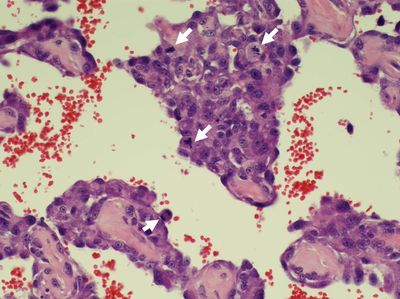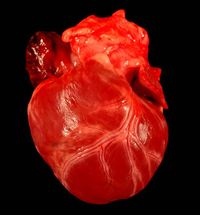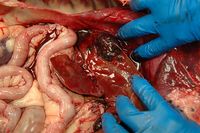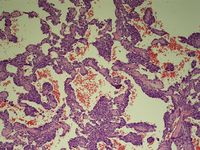Difference between revisions of "R(D)SVS VPU 01"
| Line 1: | Line 1: | ||
| + | {{VPU}} | ||
[[Image:High power.jpg|thumb|400px|left|High power micrograph of mass]] | [[Image:High power.jpg|thumb|400px|left|High power micrograph of mass]] | ||
[[Image:Gross Heart.jpg|thumb|200px|Gross heart with pericardium removed]][[Image:Liver pathology.jpg|thumb|200px|Masses in liver]][[Image:Low power.jpg|thumb|200px|Low power micrograph of mass]] | [[Image:Gross Heart.jpg|thumb|200px|Gross heart with pericardium removed]][[Image:Liver pathology.jpg|thumb|200px|Masses in liver]][[Image:Low power.jpg|thumb|200px|Low power micrograph of mass]] | ||
Revision as of 17:19, 15 July 2011
| This question was provided by the Veterinary Pathology Unit, Royal (Dick) School of Veterinary Studies. More can be seen on their Facebook page. |
You are presented with a case of a 9 year old, male neutered golden retriever. The dog had a history of sudden death. On gross examination the pericardial sac was full of blood.
Multifocal to coalescing, dark red, pinpoint to 5cm masses were also present throughout the liver.
Microscopically, the mass is composed of multiple, variably-sized, irregular, blood-filled channels and spaces.
On high power, these spaces channels are lined by plump, pleomorphic spindle cells which exhibit marked anisocytosis and anisokaryosis. The nuclei contain 1-2 dark basophilic nucleoli. Within this single high power field (400x), four mitotic figures are present (arrows). The cells are not arranged in an organised manner, instead they are ‘piled up’ on top of one another.
1 |
Which of the following is the most likely diagnosis? |



